The airport experience can either be a smooth sailing or an absolute nightmare, and the path taken is often determined by how easy it is for travellers to get in or get out, complemented by the journeys that take place within a terminal.
It is no wonder then that airports are re-thinking the way they are designed and laid out, with Perth Airport being one of the latest to upgrade its facilities and consolidate its International and Domestic Terminals.
While a large part of the airport’s expansion plan is to incorporate more intuitive way finding, improve queuing, create larger circulation spaces, and even add domestic traffic capacity to relieve pressure from the congested domestic campus, the airport’s forecourt and its drop-off and pick-up lanes also play a role in making the user journey as stress-free as possible.
Among the current additions in this space is a new floating canopy on the approach to the international terminal, designed to create a dramatic entry statement that is synonymous with the airport’s new identity, whilst integrating an ensemble of functions in a simple, undulating sweeping form.
"Our primary goal was to create an elegant, striking yet functional statement with the bus and taxi transit point, using the fabric canopies to this end with greatest effect," the design team explains. "The aim was also to create a calm, serene and clutter free environment for arriving/ departing passengers, while at the same time emphasising the symbolic aspects flight and air travel."
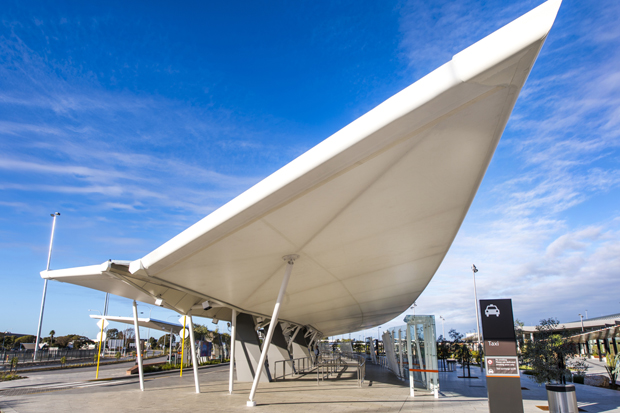
The white folding form of the canopies, reminiscent of the lines and creases of folding paper planes, create a series of winged shapes that shield passengers from the elements under its primary function as a bus and taxi shelter.
Illuminated internally via long throw LEDs, they feature a fabric-like skin wrapped over a circular profiled structural skeleton – a call out to the historical fabric winged aircrafts of aviation’s early days. In addition to the linear LEDS, all rainwater pipes and electrical services were designed to be contained within the structure.
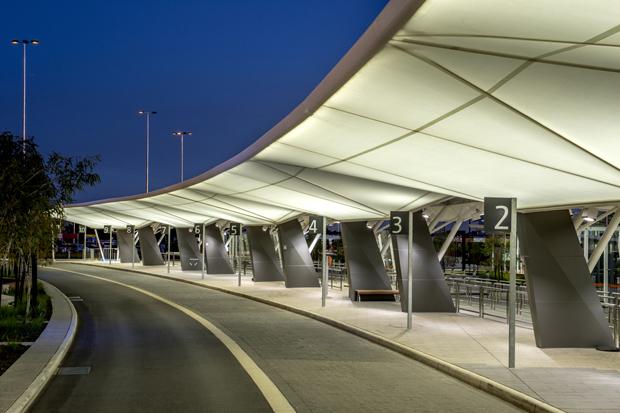
^ The LED node arrangement was specially developed and manufactured with wide and narrow lens LEDs interspersed to provide an even light distribution to the front edge of the canopy up to 8m away.
The canopies utilise a high-performance PTFE fabric, Sheerfill V from Saint-Gobain USA, which permitted the low planar forms to be achieved without ponding, while providing excellent durability and light transmission due to its Teflon coating and fiberglass yarn composition.
The sloping columns are clad with Ultrabond PVDF coated composite aluminium panels, which are facetted to reflect the planar wing aesthetic. According to the design team, this provided the necessary robustness required for its primary function as a transit point for passengers arriving and departing with buses and taxis.
“We wanted to continue drawing on the theme of aeroplane design and aviation, considering history, technical design, function and beauty simultaneously. We explored ideas that included paper folding, early plane models and wing design,” says Woods Bagot Senior Associate, Patric Przeradzki.
“Our canopy scheme creates a dramatic entry point at Perth Airport, providing passengers with protection from the elements using a lightweight, sail-like awning.”
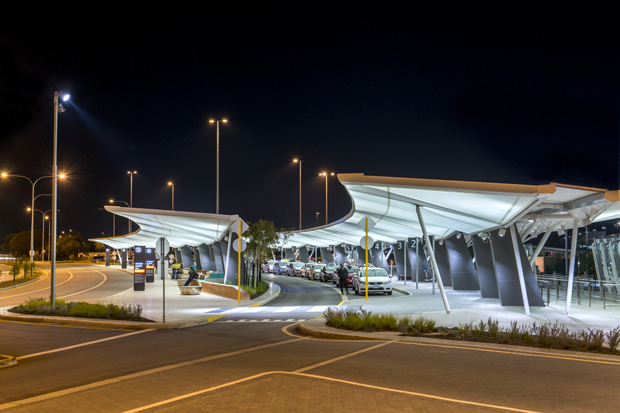
The fabric canopies allowed for substantial spans and cantilevers, which kept the frequency of pillars to a minimum. This helped to overcome a number of challenges such as the impact of footings on existing services in ground, and provided better cost efficiency compared to traditional posts and sheet metal canopies of a similar stature.
Being a modular design also supported benefits of design efficiency and future extensions, a critical consideration for Perth Airport.
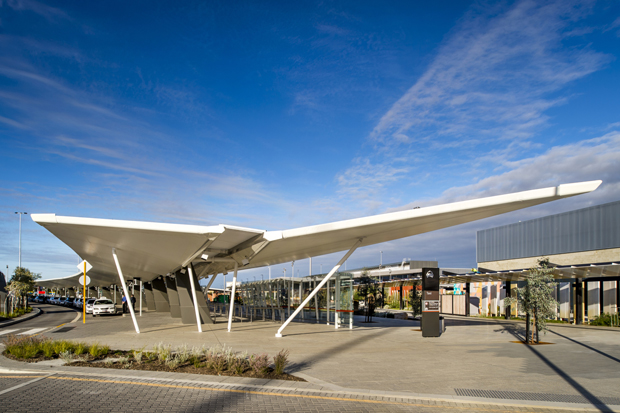
Elsewhere, planar-fixed frameless glass screens were installed by Alcom Fabrications, under sub-contract to canopies' contractors Taiyo/MakMax, to provide protention to passengers from rain and wind. These are sloped, facetted and fixed to profiled steel mullions, and echo the aesthetic of the canopies.
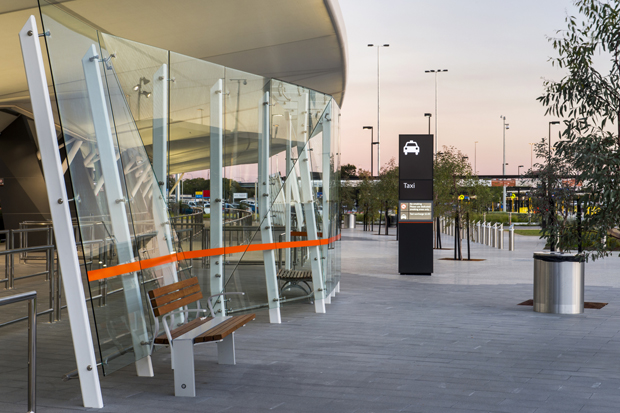
^ The profiled steel mullions are 125 x 75 x 6 RHS, manufactured in Australia, fabricated in Perth and powder-coated White. The glass is 10mm thick clear toughened glass (source unknown) with ceramic fritted Taxi graphic for way-finding. The spider fittings were stainless steel finish with articulating arms to cater for the varying angles of the glass at the facetted locations.
“A synergy of collaboration between architects, landscape and engineering specialists has ensured the realisation of this work of innovation in canopy design right down to the thoughtfulness in the detailing of junctions, waterproofing of the gentle sloped form and access to light fixtures within,” Woods Bagot concludes.
PRODUCTS
CANOPIES' PTFE FABRIC
Sheerfill V from Saint-Gobain USA
SLOPING COLUMNS
Ultrabond PVDF

